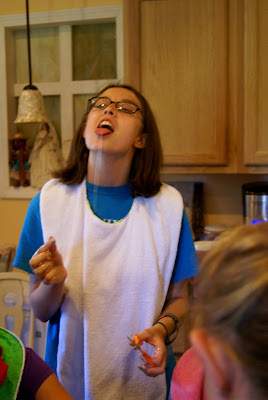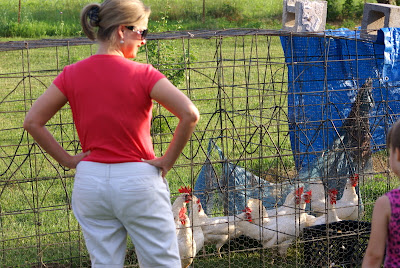But. As you will see in just a minute, Cousin Camp ended with a bang. I am just one causality. My Mom and Dad have been limping about the house tonight.
I am also finishing up a review (or two) and working on finishing a really cool yearbook project (review coming in a few weeks). So tonight (while I wait for a few pics to download for the yearbook), I am going to share one last Cousin Camp update. I might post a few odds and ends. But, this girl is due a week long nap.
I also must warning you (once again) that I am including a ridiculous number of pictures. These children's parents have been reading my updates...I want to be sure to make sure I'm not voted off the Best Big Sister in the Whole World Island.
Just after breakfast Papa took the gang out to Treasure Hunt (once again) in the pasture. I think they found some cool stuff. Though I can't remember what that cool stuff was exactly.
I do need to admit something about the little one's hat. I got it at the Thrift Store for .97. Only problem is that is personalized. It says "Brandon." I started to remove all the stitching, but got sidetracked. Oopsie.
While the Treasure Hunters Hunted, I piddled about the house. Nothing like good ole piddling. I also enjoyed this. An iced coffee. I can tell you I deserved every last drop.
After a morning of Treasurer Hunting, the Cousins gathered in to make a batch of Ama's famous Pulled Peanut Brittle. We used to make this when I was a kid. The deal is that this Peanut Brittle is a little painful to make. After it cooks, you must pull the hot candy and cut it with buttered scissors. We were only allowed to help pull it when we were 8 or 9...and promised we wouldn't cry. Nothing like a little bit of snot in the peanut brittle. But it's well worth the pain.
The Cousins have been begging for several years now to actually get make it themselves.
This is line to stir the pot. All manner of craziness is going on in that line.
The Pot. The End of the Rainbow. The Final Destination.
We also had to butter our fingertips. Payge wasn't allowed to pull the peanut brittle (she is most certainly too young to be burnt willingly by hot, molten candy). She did get to butter her fingertips. Which was so much fun. If you don't believe me, try it.
Ama demonstrates the technique.
And so it begins!
These kids were troopers. Not a bawler in the bunch!
I did have to lay down the camera to help mom finish pulling the last little bits. There was a lot of "eating on the job."
Look at that tongue!
The finished product.
That's some good stuff!
Cousin Approved.
After we gorged ourselves on peanut brittle, Ama got out her old doll collection. Some of these she has had for years. The girls got to come in (one at a time) and pick out dolls to take home.
It was very sweet and precious. I also took a few dolls. One of these days I'll get a picture of my babies.
After a lunch of PB&J, applesauce, and some very yummy cupcakes my Aunt Phyllis brought over, the Cousins gathered outside for the Great Boat Races across the Big Pond.
They really just paddled across the shallower end of the pond. And everybody had a life jacket. I'm telling you. These kids could have done this everyday, all day.
Though I must confess something. We are just a little bit Redneck. And Cheap. The paddles were actually little plastic ping pong paddles. If you can paddle a raft on the Big Pond with Ping Pong Paddles from the Dollar Store....Let's just say that these kids are going places.
Chris went first in his boat. Dude had to have a few practice runs before we allowed him to carry passengers.
Kalynn had a bit more successful first run.
Ama sat on one side of the pond and Papa stood in the water on the other. I sat on a chair and laughed. That's just I way I roll.
Josiah is a seasoned Water Guy. Though he's a bit more comfy in the water than on it.
Cade paddled that boat like a champ.
Alex in her boat. She was a pretty good little boater.
Maddy Paige. She's a hoot.
Payge went for a pleasure cruise with Kalynn. At one point she yelled, "I need something to drink." She then insisted on taking a few turns around the pond. She's four. And we just all kind of do what she wants.
At one point it was all too much for Josiah. He swam his way across the pond. Keeping his head up the whole way. I wouldn't want to put my face in that water. Don't worry. He had permission.
Payge did a little bit of sunning.
Ama got in the boat. She grew up on Lake Taneycomo in Branson. She just couldn't help herself.
And all the Cousins got in the water. And proceeded to have a wonderful time. It almost looked like a good old fashioned Baptism service.
We are considering building a dock. Just for Ama. She had a little bit of trouble getting out of her boat.
Notice our fancy dancy paddles? I guess the good thing is that at least you can color coordinate them.
That's all for now, friends. Night!







































































